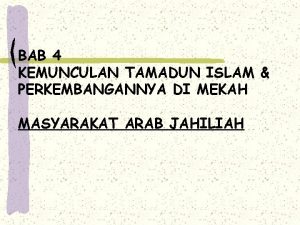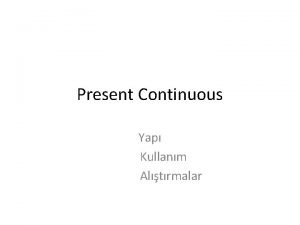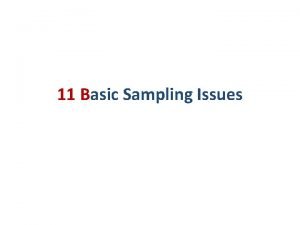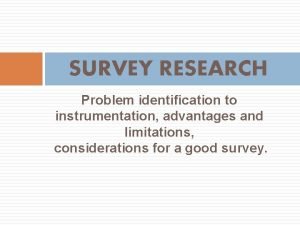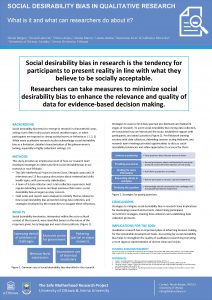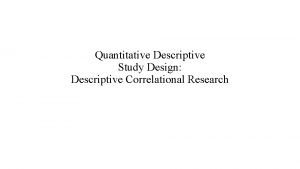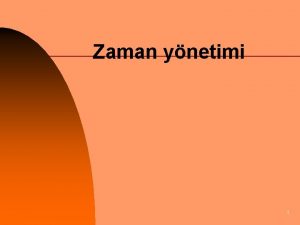Sampling in Qualitative Research Shahaduz Zaman Ph D

































- Slides: 33

Sampling in Qualitative Research Shahaduz Zaman Ph. D. Newcastle University, UK 1

Sample Eligible Population Total population 2

Quantitative Sampling : Random Sampling Sample that is representative in a statistical way of the whole population of interest In which each member of the population has an equal chances of being selected 3

Qualitative Sampling: Purposive In contrast to random sampling, information rich cases are selected according to the purpose of the study In order to get a holistic picture sampling includes a serious search for both positive and negative cases. Theoretical Sampling 4

Motto of qualitative sampling Small is beautiful Lot about little 5

Aim of sampling in qualitative research The primary purpose of sampling is to collect specific cases, events, or actions that can clarify and deepen understanding 6

Breadth Versus Depth Broader range of experiences for a smaller number of people 7

Sampling unit Quantitative Sampling samples people. Qualitative Sampling samples people, time, site. 8

Sampling people: Typical cases Deviant cases Sampling site Private Public Sampling time Day/ night Season/Personal occurrence 9

Sample size How many is enough? Enough to do justice to the subject, no more, no less 10

20 minutes interview with 200 people? vs 20 hours interview with 2 people? 11

Freud’s ground breaking theory ‘Psychoanalysis’ - Based on 10 cases studied over 5 years 12

Rule of the thumb Sufficiency Covering maximum variety of respondents Saturation Point of 13 redundancy in response

Sample determination is influenced by : Homogeneity of the group Nature and experience of the researcher 14

For At least 6 interviews For phenomenological Studies grounded theory Studies 12 interviews in each category 15 Greg Guest, Arwen Bunce and Laura Johnson (2006) Field Methods (18, 59)

Sampling Quantitative Sampling Qualitative Sampling Large samples selected randomly In depth, small samples selected purposively Sample should be representative of some larger population to which one hopes to generalize research finding Sampling driven by the desire to illuminate questions under study, and to increase the scope or range of data exposed 16

Quantitative Begins with a relatively fixed theory, eg. An explanation for something that is to be tested. Theory tested in context of random sample, using large enough N to demonstrate statistical significance 17 Qualitative Begins with ‘flexible’ theory, allowing for further revision/ decision regarding boundary of investigation, follows a process such as what data sources are ‘rich’, who should I talk to, what should I look at first. As research progresses, ask what data sources may confirm my understanding (theory) or challenge.

Sampling Strategies Maximum variation Theory based: Sampling in focused manner, based on a priory theory being evaluated Confirming/Disconfirming cases Extreme or deviant cases Stratified purposeful Snowball/Chain Sampling 18

19

Purposive sampling should never be confused with sampling for convenience. 20

Features of qualitative sampling Qualitative sampling is systematic but flexible Guided by clear research questions Sample evolves as the study progresses 21

Sample units are selected serially. Who and what comes next depends on who and what comes before Selection continues to the point of redundancy. 22

Qualitative sampling A process (Plan-Revise) Pragmatic (Time, money, personnel) Make considerations explicit/Justify what has been done 23

Warning in qualitative sampling Not too thin Not selecting the exotic Not fitting researchers ideal perception 24

Does qualitative research present bias results? What is the Generalizibility of qualitative research?

Biases Defective Instrument Observer bias Selection bias Information bias Effect of observer Bias is (partly) unavoidable

Dealing with bias in Qualitative research �Triangulation �Reflexivity �Transferability.

Types of triangulation Triangulation of methods Triangulation of sources Triangulation of researchers Triangulation of perspectives


Objectivity vs Reflexivity Objectivity: The term generally implies maintaining distance between the observer and the observed and minimizing any possible influence of the researchers value on the process of inquiry Reflexivity: A way of knowing that even as a coparticipant in the inquiry the researcher has maintained the distinction between personal values and those of the participants.

Empathic Neutrality It suggests that there is a middle ground between becoming too involved which can cloud judgment, and remaining too distant, which can reduce understanding. Reflexivity Researcher’s critical self awareness -is a vital process in which you question and observe yourself at the same time you listen to and observe the participant.

Generalizibility � Total Generalization � Statistical � Natural Generalization (Transferability)

Generalizibility vs Transferability Generalizibility Whether findings of the research can be generalized to the wider population Transferability Whether the conclusions of a study are transferable to other context.
 What is quota sampling
What is quota sampling Phenomenology research topics
Phenomenology research topics What is the sample size in qualitative research?
What is the sample size in qualitative research? Sampling techniques in qualitative research
Sampling techniques in qualitative research Present simple tense time expressions
Present simple tense time expressions Kesan negatif sistem kabilah
Kesan negatif sistem kabilah Esrarını dil zaman zaman söyler imiş
Esrarını dil zaman zaman söyler imiş Past continuous tense alıştırmalar
Past continuous tense alıştırmalar Appendices in research
Appendices in research Chapter 3 respondents of the study sample
Chapter 3 respondents of the study sample Qualitative research research design
Qualitative research research design Research design for qualitative research
Research design for qualitative research A consumer confidence researcher asks several retailers
A consumer confidence researcher asks several retailers Limitations of systematic sampling
Limitations of systematic sampling Cluster sampling vs stratified random sampling
Cluster sampling vs stratified random sampling Contoh event sampling
Contoh event sampling Stratified sampling vs cluster sampling
Stratified sampling vs cluster sampling Convenience sampling
Convenience sampling Natural sampling vs flat top sampling
Natural sampling vs flat top sampling Sample frame
Sample frame Quita sampling
Quita sampling Sampling design in research example
Sampling design in research example Qualitative paper example
Qualitative paper example Holistic data collection
Holistic data collection Qualitative and quantitative data analysis
Qualitative and quantitative data analysis Methodological integrity in qualitative research
Methodological integrity in qualitative research What is the sample size in qualitative research?
What is the sample size in qualitative research? Social desirability bias in qualitative research
Social desirability bias in qualitative research Qualitative research traditions
Qualitative research traditions Qualitative results and discussion
Qualitative results and discussion Types of qualitative questions
Types of qualitative questions What is scope in proposal
What is scope in proposal Research design approach
Research design approach Descriptive content analysis
Descriptive content analysis





